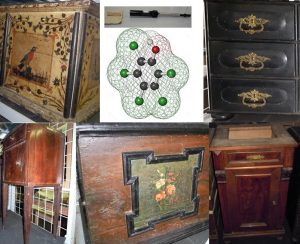Researchers from the Faculty of Chemistry and Chemical Technology of the University of Ljubljana and the National Museum of Slovenia recently published the paper Non-Destructive Detection of Pentachlorophenol Residues in Historical Wooden Objects.
As a natural material wood is important in many heritage collections. Because of its susceptibility to biodegradation, it has often been chemically treated with substances that can also be harmful to human health. One of the most widely used wood preservatives used to be pentachlorophenol (PCP), which is still present in museum objects today, although its use has been restricted for about forty years.
Museum objects need to be analysed in the least invasive way. Non-invasive (no sample taken) and non-destructive (a sample is taken but not destroyed during analysis) methods are most desirable.
In this work, two non-destructive solid-phase microextraction (SPME) methods, in the headspace and the contact mode, were developed and optimized for the detection of PCP in wooden objects. The methods were applied in the furniture store of the National Museum of Slovenia, where traces of PCP were detected in two investigated objects. Low concentrations of PCP were also detected in the indoor air of the museum furniture depot. The developed SPME methods could be used for systematic screening of wood collections (both in the store room and in exhibitions) to identify critical cases and to propose safe handling guidelines.



